bhofack2/iStock/GettyImages
A Quick Cheat for Tasty Salmon
The understated richness of salmon gives it an odd similarity to pork, and like pork, it takes beautifully to being cured and smoked. Hot- or cold-smoking a salmon requires a smoker and a degree of expertise, so smoking your own isn't always a viable option. That doesn't mean you can't fake it pretty effectively, using readily available ingredients.
How to Cook With Liquid Smoke
Liquid smoke is a potent seasoning, so you'll need to be very restrained in using it. For a full salmon fillet weighing 2 to 3 pounds, you'll only need a tablespoon or two of the flavoring. Salmon is ordinarily cured for smoking with a mixture of salt and sugar, so the simplest way to replicate the smoked salmon taste is to brush the fillet with liquid smoke, then rub it lightly with salt and sugar and refrigerate it for a few hours so the fish can absorb the salt and sugar. Then bake it until it's done and flakes easily, typically 20 to 30 minutes depending on the thickness of the fillet.
A Step Further
If you're prepared to make room in your fridge for a while, you can leave the salmon fillet to cure just as you would if you were really smoking it. There's no difference in the basic preparation, just leave the salmon in your fridge for a few days rather than a few hours. This allows time for the sugar and salt to fully penetrate the fillet with their flavors, and also to alter the salmon's texture. For an even better simulation of that compact smoked-salmon texture, put a plate or sheet pan over the salmon and weigh it down with some canned goods. The salmon will develop a tight, smooth texture, which lingers even after it's baked.
Cold-Smoked Salmon
Hot-smoked salmon cooks in the heat of the smoker, giving it the same flaky texture as any other cooked salmon. Cold-smoked salmon is different: It's "cooked" by curing with salt and sugar, then smoked at low temperature to impart flavor while leaving it with the silky-smooth texture of uncooked salmon. You can re-create this at home too, by leaving the salmon to cure in your fridge. You'll follow the same process of seasoning and wrapping the salmon, except leaving it uncooked means you'll need more salt and sugar to create a food-safe cure. Pressing the salmon under a weighted sheet pan is a necessary part of the process, because that's what gives the salmon its dense, sliceable texture.
If you leave off the liquid smoke, and flavor the salmon with aquavit and dill instead, your end result would be gravlax. The salmon is perfectly safe to eat, if you've used the proper quantities of salt and sugar and kept it refrigerated, but for added safety it's best to use previously frozen "sushi-grade" salmon, because freezing kills any potential parasites.
Alternatives to Liquid Smoke
Liquid smoke isn't your only way to acquire that smoked salmon taste. If you have gourmet smoked salt in your pantry, you can substitute that for the regular salt and omit the spoonful of liquid smoke. You might also opt for hickory smoke powder, which is available regionally or through online suppliers. A more widely available option is smoked paprika, which deepens the color of the salmon and adds both a smoke flavor and a fruity sweet-pepper undertone that complements the salmon beautifully.
Related Articles
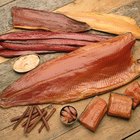
How Do I Cold-Smoke Fish?
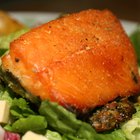
How to Brine a Grilled Salmon

How to Cook Jamaican Jerk Salmon
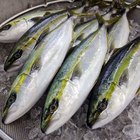
The Best Way to Smoke Yellowtail

How to Brine Fish Before Cooking It
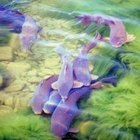
How to Smoke Catfish

How to Make Salt Brine

Baking Partially Frozen Salmon
Can I Smoke Skinless Cod?

How to Sugar Cure Bacon
How Long Do You Smoke Ham Per Pound?

How Long Does It Take for Salmon to ...

Ways to Cook Salmon Without Butter
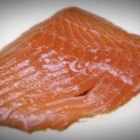
How to Make Homemade Smoked Salmon
How to Cook Salmon to Moist & Tender ...
How to Cook Atlantic Salmon Fillets

How to Cook Frozen, Boneless & Skinless ...
How to Cook a Spiral Ham on the Gas ...
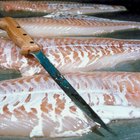
How to Grill a Cod Fish

How to Cook a Pork Loin Fillet
References
Writer Bio
Fred Decker is a trained chef and prolific freelance writer. In previous careers, he sold insurance and mutual funds, and was a longtime retailer. He was educated at Memorial University of Newfoundland and the Northern Alberta Institute of Technology. His articles have appeared on numerous home and garden sites including GoneOutdoors, TheNest and eHow.